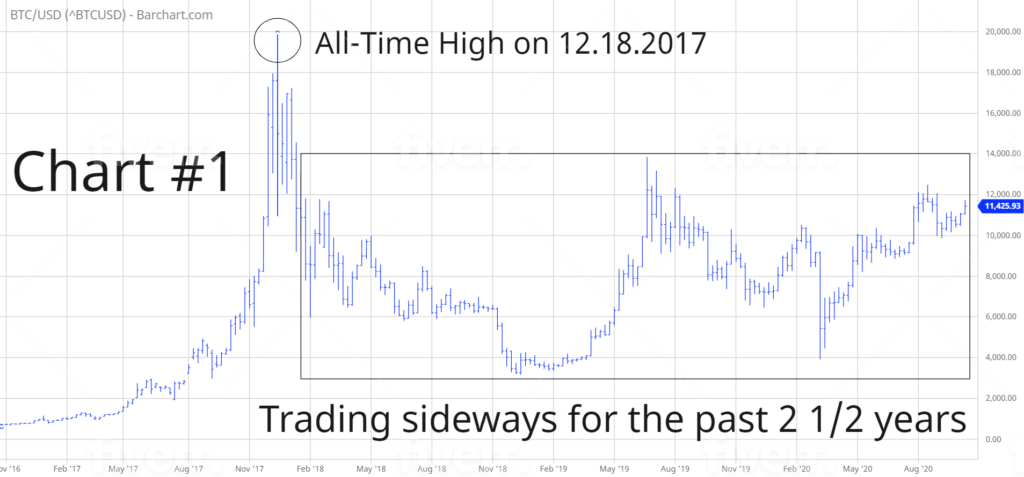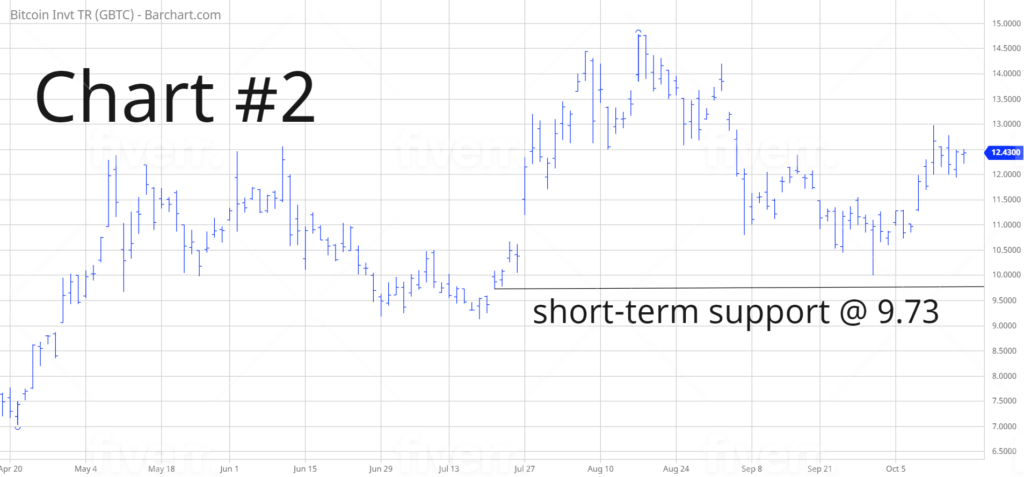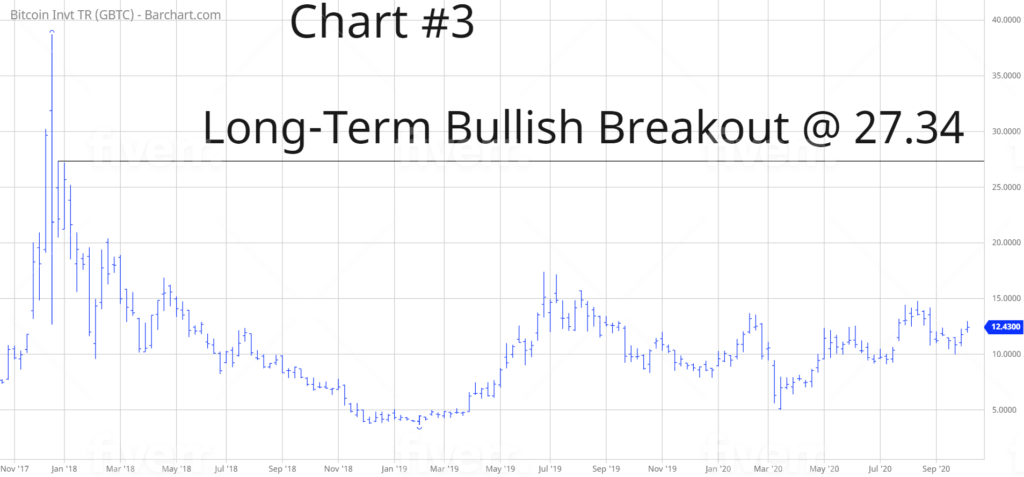
Bitcoin Investment Trust (GBTC)
Key Statistics
Minor Support Level 9.73 Minor Resistance Level 14.37
Major Support Level 2.01 Major Resistance Level 27.34
Minor Buy Signal 14.77 Minor Sell Signal 9.25
Major Buy Signal 28.01 Major Sell Signal 1.31
SHORT-TERM VIEW – Bitcoin GBTC
When Satoshi Nakamoto launched Bitcoin on 3 January 2009, he had no idea that Bitcoin would unleash the greatest monetary dislocation in our nation’s history. Over the course of the past decade, Bitcoin has completely disrupted the legacy financial system. In 2009, Bitcoin was a worthless “pet rock.” Today, this digital currency is reshaping the way people think about money.
Global leaders are currently working behind the scenes to create a new monetary system. Within the next decade, the International Monetary Fund (IMF) and the World Bank will roll out a blockchain-based digital currency structure in order to replace our current fiat money system. Bitcoin will be linked to this new arrangement. Will this new digital currency replace paper money like the US Dollar? The answer is “Yes.” However, it won’t happen any time in the near future. Most likely, paper money will be slowly phased out of existence over the course of the next 10 to 20 years.
Bureaucratic governments are usually the last group to adopt new structural changes, particularly if it involves technology. Therefore, we should not be surprised that individuals and businesses have been using Bitcoin and other blockchain-based digital currencies for the past decade. Private use has increased dramatically since 2017. This trend will increase exponentially over the course of the next 5 to 10 years. Let’s review a few examples of how Bitcoin has infiltrated the domestic economy.
Coinbase
Since 2011, several companies have launched cryptocurrency (i.e. crypto) exchanges. These exchanges allow investors to buy and sell various cryptocurrencies, including Bitcoin. Coinbase is the largest crypto exchange. Launched in 2012, Coinbase has over 35 million customers in 100 different countries. In fact, Coinbase has more accountholders than Vanguard, the world’s largest mutual fund company. Coinbase is also larger than Charles Schwab, the largest domestic brokerage firm. During the peak of the Bitcoin bull market in Q4 2017, Coinbase was opening over 10,000 accounts per day. Coinbase will have 100 million accounts by the end of this decade.
- Coinbase – 35 million customers
- Charles Schwab – 28 million customers
- Vanguard – 25 million customers
Kraken
Kraken is another crypto exchange located in San Francisco, CA. Launched in July 2011, Kraken is the second largest crypto exchange in the United States and fourth largest in the world. On 16 September, Kraken received a banking charter from the Wyoming State Banking Board, making Kraken the first cryptocurrency exchange to be officially licensed as a bank. This represents a monumental event in the brief history of digital currencies and blockchain technology.
The floodgates have been opened. A tsunami of crypto exchanges and institutional crypto investors will follow Kraken’s lead by obtaining a US banking license and competing head-to-head with traditional banks for customer accounts and customer deposits. What will be the response from the banking industry? Will legacy banks enter the cryptocurrency industry by providing their customers with access to digital currencies, crypto loans, crypto debit cards, tokenized securities and crypto custodial services? Most likely, several of the large money center banks are currently working on a plan to enter the world of cryptocurrencies. Many banks will ignore the mad rush into digital assets by refusing to add crypto services to their list of products. These banks will follow companies like Sears, JCPenney, Blockbuster and Neiman Marcus into the dustbin of history.
BlockFi
BlockFi is a cryptocurrency financial services provider headquartered in Jersey City, NJ. The company offers lending services, deposit accounts and trading services to individual and institutional clients. These financial products are offered in cryptocurrencies instead of US Dollars. For example, customers can obtain a loan from BlockFi using Bitcoin as collateral for the loan. The proceeds of the loan are dispersed to the customer in US Dollars. Crypto-secured loans can have a maximum term of 3 years, with no prepayment penalty. Customers can also open a crypto deposit account and earn an interest rate of 5% to 8% per year. BlockFi is backed by some of the most financially-secured venture capitalist firms in the US.
Bakkt
Bakkt is a Bitcoin futures exchange located in Atlanta, GA. The company launched its operation in September 2019. Bakkt customers can buy and sell Bitcoin futures contracts on a regulated exchange. Bakkt is not the first company to offer Bitcoin futures. The Chicago Mercantile Exchange (CME) became the first futures exchange to offer a Bitcoin derivatives product in December 2017.
Providing investors with access to Bitcoin derivatives is a major accomplishment for the cryptocurrency industry. It legitimizes Bitcoin and other crypto products as a major asset class by allowing investors the opportunity to hedge their exposure to digital currencies like Bitcoin. Prior to the launch of Bitcoin futures in December 2017, institutional investors avoided digital currencies because there was no way to hedge the risk. Most likely, institutions will be the driving force of the next bull market in Bitcoin.
MicroStrategy
MicroStrategy was founded by Michael Saylor in November 1989. The company develops software designed to help businesses analyze internal and external data in order to make better decisions. In August, MicroStrategy made history by becoming the first publicly traded company to invest its cash holdings in Bitcoin. Saylor and the company’s board of directors decided that Bitcoin offered the greatest potential for long-term capital preservation. Saylor claimed that cash in a bank would continue to lose purchasing power over the course of the next few decades as the Federal Reserve continued to print unlimited sums of money. Bitcoin, Saylor argued, would maintain its purchasing power because the supply of Bitcoin is limited to 21 million.
Two weeks after MicroStrategy purchased $450 million in Bitcoin, Square CEO Jack Dorsey, transferred $50 million of the company’s cash holdings to Bitcoin. Dorsey made the same argument as Saylor, that cash in a bank is slowly becoming worthless thanks to Federal Reserve money printing. Bitcoin is a much better long-term solution.
This is just the tip of the iceberg. During the next few years, several companies (both public and private) will reach the same conclusion as MicroStrategy and Square. They will realize that corporate cash reserves will continue to erode in value, while Bitcoin will provide long-term protection from excessive central bank money printing.
According to Moody’s Investor Service, publicly traded companies held $1.55 trillion in cash balances at the end of 2019. Most likely, a substantial portion of this money will be allocated to Bitcoin as we move into the 2020s. These corporate CEOs and board members are fully aware that the purchasing power of cash reserves is quickly eroding. Thanks to its limited availability, Bitcoin is the solution to this problem.
Institutional investments will be the catalyst to launch the next bull market in Bitcoin. Essentially, Bitcoin has been trading sideways for the past three years. Corporate cash balances will propel Bitcoin to much higher prices throughout the 2020s.
In an effort to provide investors with exposure to Bitcoin, Grayscale Investments LLC introduced the Bitcoin Investment Trust. This Grayscale product is not an exchange traded fund (ETF). Instead, the trust is considered a private investment vehicle, not registered with the Securities and Exchange Commission (SEC) under the Investment Company Act of 1940. Despite its unique registration status, shares of the Bitcoin Investment Trust are freely traded on the OTC market. The product was launched on 4 May 2015, using the ticker symbol GBTC. The first trade occurred @ .4615 per share (less than 50 cents per share). GBTC has become incredibly popular during the past few years. It’s not uncommon for daily volume to exceed 5 million shares.
LONG-TERM VIEW
COVID-19 has dramatically changed the economic landscape in the United States and around the globe. Several industries have been demolished. Many of these jobs will never return. However, at the same time, COVID-19 has created enormous employment opportunities in other areas. For example, technology-based jobs have increased substantially during the past six months. This trend was already in full swing prior to COVID. However, the global pandemic has accelerated this trend.
One of the fastest growing sectors in technology is in digital assets, blockchain technology, decentralized finance and cryptography. The job opportunities are incredible. During the past 12 months, there has been a 600% increase in the number of companies searching for people with experience in cryptocurrencies and blockchain technology. In 2019, there was a 6,000% increase in the number of crypto-related job postings listed on employment websites like Monster and Indeed. This trend will continue for the next decade.
These job opportunities are only available for people who understand cryptocurrencies and blockchain technology. This requires education beginning at the high school level. Based on a recent survey conducted by a major crypto firm, 90% of US high school students have never heard of blockchain technology or cryptocurrencies.
Colleges and universities are beginning to realize the huge employment potential in digital currencies, blockchain and cryptography. Over 60% of all major colleges now offer at least one course in crypto and blockchain. Many of these colleges require their business majors and computer science majors to take a blockchain course.
In 2019, the education minister in the country of France enacted legislation requiring all high school students to take a course in cryptocurrencies before graduating. The United States is falling behind in regard to educating students about this new technology.
The Price Of Bitcoin
Satoshi Nakamoto unveiled Bitcoin to the world on 3 January 2009. For the first two years of its existence, Bitcoin was practically worthless. The first recorded price was $0.003 per Bitcoin in March 2010. Bitcoin exceeded 1-cent per Bitcoin in July 2010. The price exceeded $1.00 for the first time in February 2011. Bitcoin experienced a massive bull market in 2013, by exceeding $1,000 in November of that year. Another bull market occurred in 2017. Bitcoin recorded its all-time high of $19,862 on 18 December 2017. During the past few years, Bitcoin has traded sideways, probably gearing up for another bull market in 2021 (Chart #1). Of course, it’s impossible to predict the future value of any speculative asset, including Bitcoin.
If you missed out on the internet mania during the 1990s, Bitcoin is your chance to participate in the next big technological revolution. For the first time in history, humans have figured out how to create a digital monetary network that is disinflationary in nature. Why is Bitcoin disinflationary? Because there will never be more than 21 million coins in circulation. This is what separates Bitcoin from all other asset classes. Additionally, this explains why institutional investors will continue to transfer their cash holdings into Bitcoin. Institutions have finally realized that Bitcoin is the perfect hedge against monetary debasement.
Of course, the million dollar question is, “How will this affect the price of Bitcoin?” Obviously, it’s impossible to accurately forecast the price of any financial asset. However, a conservative long-term forecast could easily be based on the assumption that Bitcoin will become the ultimate hedge against inflation. If Bitcoin fulfills its role as an inflation hedge, the price should exceed the market capitalization of gold within the next decade. The current market cap of gold is $9 trillion. The total supply of Bitcoin is 21 million. Therefore, Bitcoin should approach $428,571 by the end of 2030.
SHORT-TERM TREND
Please review the 6-month chart of GBTC (Chart #2). Essentially, this investment vehicle has been trading sideways for the past few months. However, the bulls did manage to create a nice breakout near the end of September. So far, the bulls have been able to maintain the momentum. The next level of resistance is 14.37. The bears need a weekly close below 9.73 to reverse the chart pattern. Most likely, GBTC will continue to trade sideways.
LONG-TERM TREND
Please review the 3-year chart of GBTC (Chart #3). An argument could be made that GBTC has been in a secular bull market since the first trade was initiated on 4 May 2015. Despite the brutal decline in Q1 2019 and Q1 2020, GBTC never penetrated the lows from 2015. Therefore, the chart pattern continues to remain bullish. The next level of resistance is 27.34. The bears need a weekly close below 2.01 in order to capture the momentum. This type of decline is extremely remote. Bitcoin must drop below $1,000 to push GBTC into a long-term bear market. Of course, anything is possible.
Important Disclosure
It’s impossible to forecast the price of anything, particularly a new asset class like digital currencies.
Don’t make any investment decisions based on long-term forecasts. Before you decide to invest, do your own research. Talk to a licensed investment professional.
Bitcoin and other cryptocurrencies are incredibly volatile. This new technology has only been in existence for ten years. Therefore, it’s impossible to forecast how digital currencies will behave in the future. They could become completely worthless. Investing in cryptocurrencies is not suitable for most people. Never invest more than you can afford to lose. Before you decide to invest, speak to a licensed investment professional.




